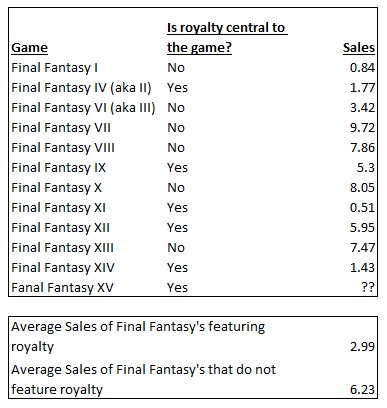 With the excitement building about Final Fantasy XV FINALLY coming out this year, there is a lot of buzz about the series once again. However, Cracked isn’t so optimistic about the franchise these days.
With the excitement building about Final Fantasy XV FINALLY coming out this year, there is a lot of buzz about the series once again. However, Cracked isn’t so optimistic about the franchise these days.
So I decided to dig into the numbers a bit and see if we can uncover just what exactly is going on at Square Enix these days and what their approach is with one of my favourite game franchises.
Here you can see every core Final Fantasy game and their core spinoffs:

Note that I excluded rereleases or expansion packs since they are likely purchased by the same consumers who bought one of the above games already.
One of the most obvious things you can see is that Square Enix has a strategy of creating core game sequels for single-player RPG fans while the company tries to reach MMORPG fans. (Each of Final Fantasy XI and XIV are MMORPGs)
Square Enix’s Strategy for Spacing Between Games
Many fans feel like it has taken way too long for the next (non-MMORPG) Final Fantasy to come out. However, from the data, you can see if we treated sequels like core final fantasy games, we would still be getting new games at around the same pace as the Final Fantasy glory years of the 1990’s. As well, even if we compare the time since XIII to the time between X and XII, Square Enix has still only taken a year longer than the previous gap between single-player Final Fantasy’s.
There is also the matter of Final Fantasy XIV. The game was considered a flop. Rather than forget about it and move on, Square Enix remade the entire game! Which meant resources that could have been allocated to making the next single-player Final Fantasy went towards XIV. And, given the company strategy of biding time between single-player core Final Fantasy’s with single-player sequels, that is likely why we have Lighting Returns.
This strategy might have worked with a game like Final Fantasy VII. The characters were quite complex and worth exploring further in another game. If VII came out today, releasing Dirge of Cerberus and the many other VII spinoffs likely would have worked extremely well to keep fans happy until the next single-player Final Fantasy came out. Clearly fans are not adverse to sequels either, as you can see by the fact that X-2 sold about as well as XII.
However, the big issue over the last few years was that Final Fantasy XIII wasn’t that deep of a game to begin with. So making sequels around characters that weren’t particularly interesting or popular led to the sequels not being well-received which made the wait until Final Fantasy XV feel even longer.
Going by the data, if Square Enix decided to write off XIV and not make Realm Reborn, we probably would already be playing XV.
What to Expect from Final Fantasy XV?
Because Square Enix’s most recent string of games have been average at best (going strictly by sales), Final Fantasy XV has to be extremely good in order to help the brand recover. As any Final Fantasy fan knows, while each core game stands on its own, some are set in a world where royalty plays a role (i.e. there are princes, princesses, etc), while others are more “modern”. For example in Final Fantasy VII the main characters are fighting a giant corporation. So I decided to compare Final Fantasy games where royalty plays an important role, vs. the Final Fantasy games where they do not:

Things are not looking too good for Final Fantasy XV!! I really hope the game is awesome but thank’s to Square Enix’s release strategy and the historical performance of various types of Final Fantasy games, as mentioned, XV is going to have to be very good to help the Final Fantasy brand rebound.
Pingback: Square Enix is Playing a Very Dangerous Game With Final Fantasy XV | MBA Video Gamer